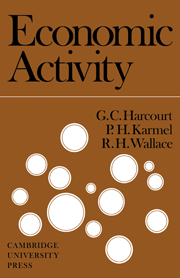Book contents
- Frontmatter
- Preface
- Contents
- 1 INTRODUCTION
- 2 THE NATIONAL ACCOUNTS AND THE INCOME–CREATION PROCESS
- 3 THE PRODUCTION–INCOME–EXPENDITURE CIRCUIT AND NATIONAL ACCOUNTING IDENTITIES
- 4 THE DETERMINATION OF THE EQUILIBRIUM LEVEL OF REAL INCOME
- 5 THE CONCEPT OF FULL EMPLOYMENT
- 6 MONEY IN THE ECONOMIC PROCESS
- 7 THE BANKING SYSTEM AND THE QUANTITY OF MONEY
- 8 THE CONSUMPTION FUNCTION
- 9 THE DETERMINANTS OF INVESTMENT EXPENDITURE
- 10 THE EFFECT OF CHANGES IN EXPENDITURE PLANS: THE MULTIPLIER CONCEPT
- 11 THE GOVERNMENT SECTOR AND THE DETERMINATION OF REAL INCOME
- 12 THE OPEN ECONOMY
- 13 THE INTERACTION BETWEEN PLANNED EXPENDITURES AND FINANCIAL FACTORS
- 14 INFLATION
- 15 ECONOMIC POLICY
- List of suggested reading
- Index
2 - THE NATIONAL ACCOUNTS AND THE INCOME–CREATION PROCESS
Published online by Cambridge University Press: 18 December 2009
- Frontmatter
- Preface
- Contents
- 1 INTRODUCTION
- 2 THE NATIONAL ACCOUNTS AND THE INCOME–CREATION PROCESS
- 3 THE PRODUCTION–INCOME–EXPENDITURE CIRCUIT AND NATIONAL ACCOUNTING IDENTITIES
- 4 THE DETERMINATION OF THE EQUILIBRIUM LEVEL OF REAL INCOME
- 5 THE CONCEPT OF FULL EMPLOYMENT
- 6 MONEY IN THE ECONOMIC PROCESS
- 7 THE BANKING SYSTEM AND THE QUANTITY OF MONEY
- 8 THE CONSUMPTION FUNCTION
- 9 THE DETERMINANTS OF INVESTMENT EXPENDITURE
- 10 THE EFFECT OF CHANGES IN EXPENDITURE PLANS: THE MULTIPLIER CONCEPT
- 11 THE GOVERNMENT SECTOR AND THE DETERMINATION OF REAL INCOME
- 12 THE OPEN ECONOMY
- 13 THE INTERACTION BETWEEN PLANNED EXPENDITURES AND FINANCIAL FACTORS
- 14 INFLATION
- 15 ECONOMIC POLICY
- List of suggested reading
- Index
Summary
This chapter differs from the others of this book in that it is designed, first, to explain a method of looking at the economy and, secondly, to define the basic concepts and measures—in particular, national product, national income and domestic expenditure—which are used below in the analysis of the determination of the level of economic activity. As economic activity is measurable it is important to understand exactly what each concept and measure means. It is also necessary to construct the national accounting framework, for the relationships between the economic aggregates of the later chapters are fitted into this framework. The following discussion is based upon two publications of the Commonwealth Statistician, the White Paper National Income and Expenditure which is published with the Budget Papers each August, and a recent publication, Australian National Accounts. It should be noted that three terms used in the text, viz. gross national income (GNI), gross market expenditure (GME), and gross domestic expenditure (GDE), are not used in these official publications. However, the terms are applied to aggregates of items, details of which are given in these publications.
Entities and sectors
Reduced to the simplest terms the economic process consists of the production of goods and services, the rationale of which is their use either for consumption or for the production of additional goods and services. In modern economies, the producer of a good is not usually its consumer: goods must be transferred from producers to consumers.
- Type
- Chapter
- Information
- Economic Activity , pp. 7 - 23Publisher: Cambridge University PressPrint publication year: 1967



